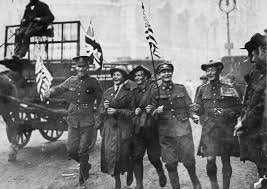Armistice Day: WWI was meant to be the war that ended all wars. It wasn’t.
It was the British author, H.G. Wells, that coined the expression: “The war that will end war” to describe World War One, which had broken out in Europe in September 1914. Wells believed the conflict would create a new world order that would make future conflict impossible.
It would do so, Wells believed, by crushing the militarism of Germany under the Kaiser and its allies, the Austro-Hungarian and Ottoman empires. The Allies – Great Britain, France, and Russia – were, Wells wrote, not only soldiers in a war but “crusaders against war”.
“There shall be no more Kaisers […]. We are resolved. That foolery shall end! It is the last war.”
Wells’ belief was that the militarisation of Europe at the beginning of the 20th century, and particularly the manufacture of heavy armaments and modern weapons, had been pioneered by Germany and had spread outwards, forcing Europe as a whole down the same path.
He was making the argument at a time when many in Britain did not believe that the country should join France and Russia in fighting Germany and Austria-Hungary in the war, sparked by the assassination of Archduke Franz Ferdinand in Sarajevo by a Bosnian Serb nationalist.
Wells first wrote the phrase in August 1914 and within weeks it had become a mantra. But while in 1914 its sentiment was optimistic – positive, even – by 1918 it was desperate. Europe was in ruins, millions were dead. It had to be the last war because Europe could not have another.
World War One was the end of a number of things: It led to the collapse of no less than four empires. The Weimar Republic replaced the German Kaiser, the Ottoman and Austro-Hungarian empires fell, and in 1917 the Bolsheviks overthrew Tsar Nicholas II.
Armistice Day: Why is it the 11th Hour of the 11th Day of the 11th Month?

On the eleventh day of the eleventh month – November- at 11am marks the time World War I officially came to an end in 1918.
Armistice Day takes place on 11 November each year and marks the end of the First World War. It is a day of commemoration, an occasion to remember the some 8.5 million soldiers who died across the world during the 1914–18 war – as well as those lost in the conflicts that followed.
At 2.05am on 11 November 1918, after four years of conflict, a German delegation sat down in the railway carriage of Allied supreme commander Marshal Ferdinand Foch, a few hours’ north of Paris. Talks had gone on for three days, and the German delegates were close to accepting the terms for an armistice, a formal agreement to end the fighting.
The Germans had been defeated after a brutal summer of attrition; over the past four months, Allied and American forces had overwhelmed the final line of German defences in the battles of the Hundred Days Offensive. On 9 November 1918, Kaiser Wilhelm II had been persuaded to seek asylum in the Netherlands.
In the early hours of 11 November, final terms were laid out and at 5.12am, the armistice was signed. It declared the “cessation of hostilities by land and in the air six hours after the signing”. Terms of the agreement included: the immediate German withdrawal from the territories they had acquired during the conflict; the disarmament and demobilisation of the German military; and the release of Allied prisoners. The terms made it impossible for Germany to resume any fighting.
This was the last of the September–November 1918 armistices between the warring nations, and peace came into effect six hours after the armistice was signed, at 11am – or at the “eleventh hour of the eleventh day of the eleventh month”. It has been estimated that during the time between the signing and the announcement of peace, the war produced a further 11,000 casualties.
French Marshal Ferdinand Foch (second from the right), in Compiègne Forest, minutes after the signature of the Armistice. Wikicommons

The armistice was never intended to be a permanent peace treaty between the nations; this would be attempted with the Treaty of Versailles, signed seven months later. In January 1919, the leaders of 32 countries met in Paris – without Germany. Negotiations were led by the ‘big three’: British prime minister David Lloyd George; French prime minister Georges Clemenceau; and US President Woodrow Wilson.
The actual terms of the deal, largely written by the Allied Supreme Commander Marshal Ferdinand Foch, included the cessation of hostilities, the withdrawal of German forces to behind the Rhine, Allied occupation of the Rhineland and bridgeheads further east, the preservation of infrastructure, the surrender of aircraft, warships, and military material, the release of Allied prisoners of war and interned civilians, and eventual reparations.
No release of German prisoners and no relaxation of the naval blockade of Germany was agreed to.
Although the armistice ended the fighting, it needed to be prolonged three times until the Treaty of Versailles, which was signed on June 28, 1919, and took effect on January 10, 1920.
The aim of the treaty was to make sure that Germany would never again pose a military threat to the rest of Europe. It left Germany with reduced territories, a significantly smaller army and navy, and the duty to assume ‘war guilt’ and pay an unspecified amount of ‘reparations’ to the Allies.
The terms of the treaty were considered harsh by many, and British prime minister David Lloyd George predicted: “We shall have to fight another war again in 25 years’ time.”

London on November 11th 1919 – a two minute silence at 11 o’clock to observe the first anniversary of the end great war. This photograph by an unknown artist conveys the collective grief of a people. To stand in that crowd in the stillness and silence for two minutes – the individual weight of personal loss and mourning magnified beyond imagination.
Armistice Day: WWI was meant to be the war that ended all wars. It wasn’t.
The Europe that came next was certainly not the new social order that Wells had hoped to see – and it was not the end of war. Just 15 years later, Adolf Hitler became Germany’s chancellor and Europe was again on the path to a brutal and epoch-defining conflict.

Armistice Day is not to be confused with Remembrance Sunday, which is marked on the second Sunday of November each year, Armistice Day has been commemorated on 11 November since the first anniversary of the end of the First World War, in November 1919. As part of the first year events, King George V hosted a banquet at Buckingham Palace “in Honour of The President of the French Republic”. A two-minute silence was also held for the fallen, and ever since it has since been a tradition in Britain to pause for a two-minute silence at 11am on 11 November to remember those killed in the war. This has since been extended to commemorate the lives lost in other conflicts.
Over the last century, the day has become a more sombre day of reflection, marked with poppies and respectful silence. However, 11 November 1918 was a moment of wild celebration for many. “The day the war ended was a weird and wonderful carnival rather than the day of mournful seriousness that Armistice Day would become in later years,” wrote Guy Cuthbertson for BBC History Magazine. “The armistice brought church services and tears, but it was a day of joy, spontaneity, noise and fun.”
Britain continued to refer to 1914–18 as ‘the Great War’in the 1920s and 1930s, but after 1945 they adopted American terminology and spoke of ‘the First World War’ and the ‘Second World War’. According to David Reynolds, professor of international history at the University of Cambridge, this changed the nature of commemoration. “After 1945, both Armistice Day on 11 November and the Two-Minute silence fell out of fashion. Instead, the dead of both world wars were honoured on the nearest weekend, known as Remembrance Sunday,” he explained in an article for BBC History Magazine.
For Reynolds, the last third of the 20th century stands in contrast with what had come before, as, with the retreat from empire, compulsory military service was abandoned. “Apart from the Falklands, foreign wars seemed a relic of the past,’ he writes. “But over the last quarter-century, war has returned to our national agenda, in the Gulf, Iraq and Afghanistan. The deaths of young soldiers today gives new life and meaning to stories and poems from Britain’s greatest war. The two-minute silence has gained new resonance, likewise the poppy appeal.”
The opening of the article on H.G.Wells was taken from a EuroNews special Link
Support Independent Journalism Today
Our unwavering dedication is to provide you with unbiased news, diverse perspectives, and insightful opinions. We're on a mission to ensure that those in positions of power are held accountable for their actions, but we can't do it alone. Labour Heartlands is primarily funded by me, Paul Knaggs, and by the generous contributions of readers like you. Your donations keep us going and help us uphold the principles of independent journalism. Join us in our quest for truth, transparency, and accountability – donate today and be a part of our mission!
Like everyone else, we're facing challenges, and we need your help to stay online and continue providing crucial journalism. Every contribution, no matter how small, goes a long way in helping us thrive. By becoming one of our donors, you become a vital part of our mission to uncover the truth and uphold the values of democracy.
While we maintain our independence from political affiliations, we stand united against corruption, injustice, and the erosion of free speech, truth, and democracy. We believe in the power of accurate information in a democracy, and we consider facts non-negotiable.
Your support, no matter the amount, can make a significant impact. Together, we can make a difference and continue our journey toward a more informed and just society.
Thank you for supporting Labour Heartlands









